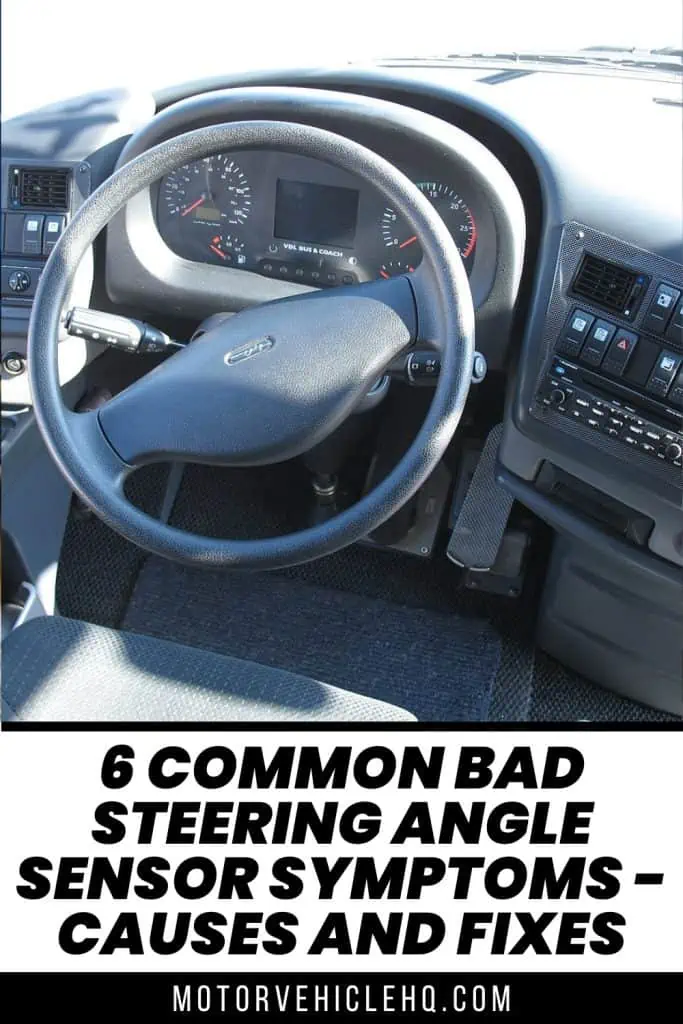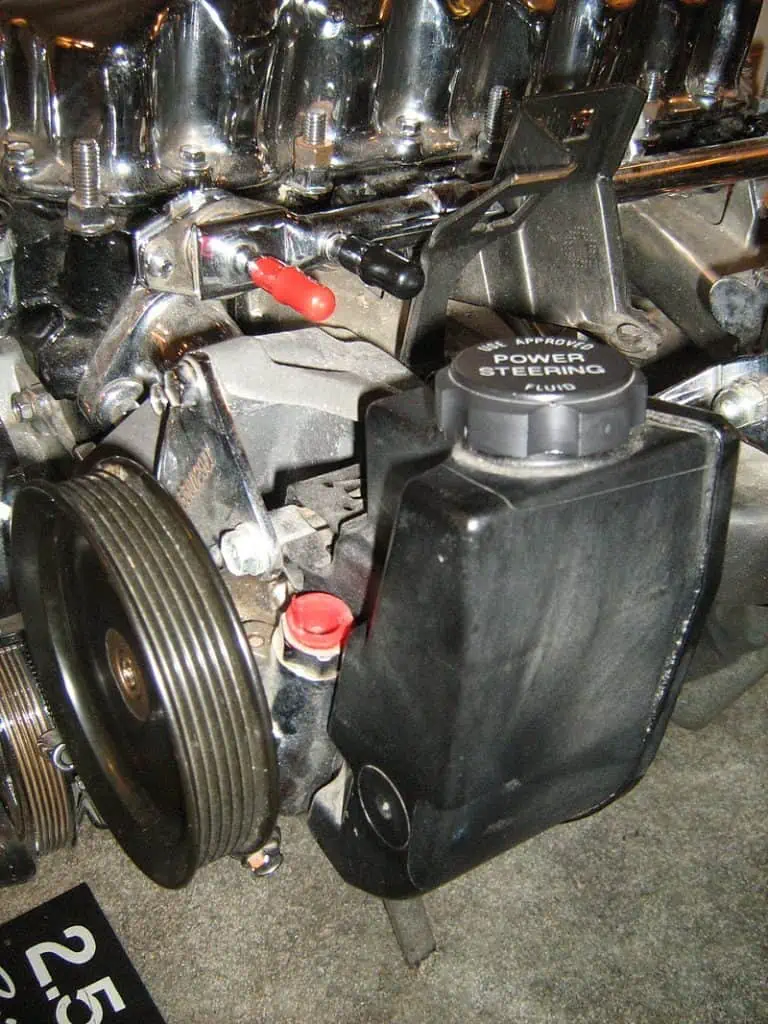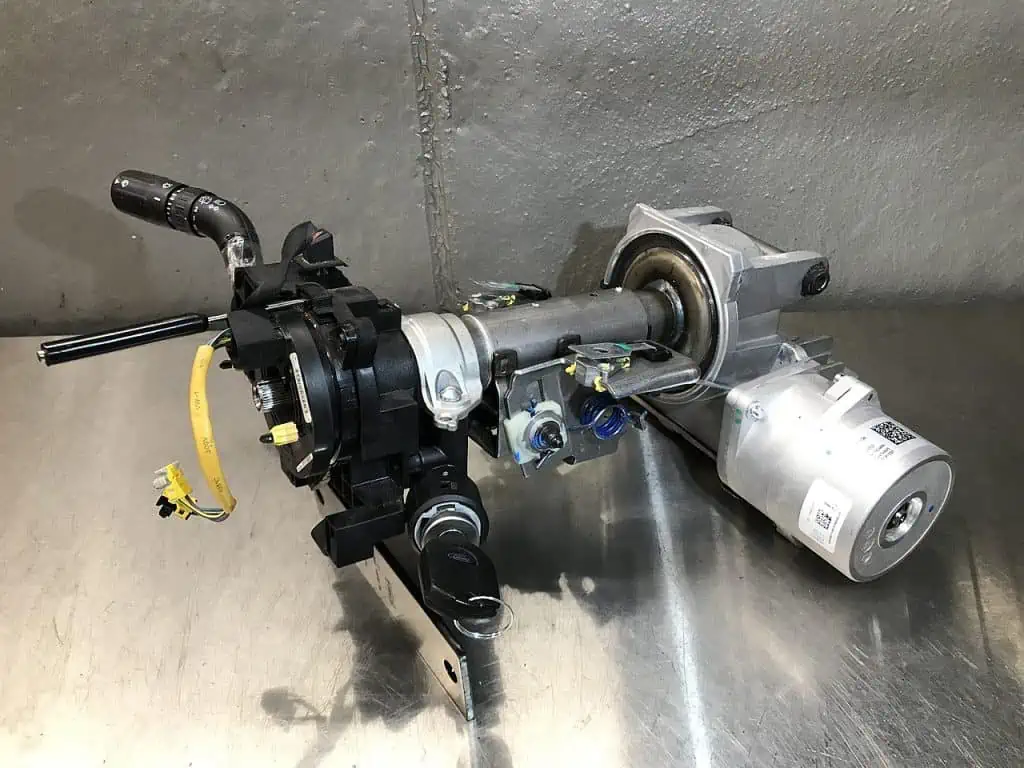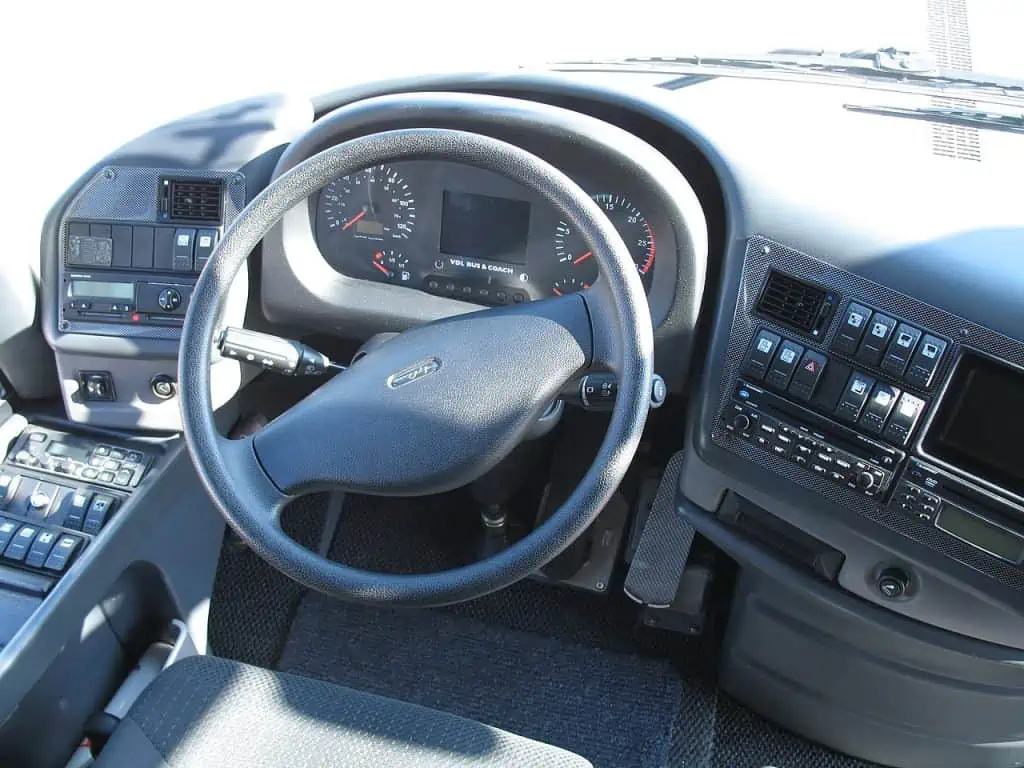Nobody likes to have car problems, but sometimes they just do. Continue reading to learn about the typical signs, causes, and fixes for this problem if you believe your automobile may be experiencing issues with the steering angle sensor.
A steering angle sensor is a transmitter that keeps track of crucial steering information, including the speed and angle of the steering components. It is in charge of signaling other systems, including the electric power steering, and syncing the steering wheel’s movements with the vehicle’s wheels.
The many control modules in your car employ the steering angle sensor for a variety of purposes. Here’s how to identify a malfunctioning steering angle sensor.
Numerous sensors are connected to the PCM, the vehicle’s main computer, in modern vehicles. The steering angle sensor is one sensor that monitors the vehicle’s stability and traction. The stability technology in the car—known by several names—is connected to this sensor.
The stability technology employed by each manufacturer in their vehicles goes under a different name, but this doesn’t affect the reality that the technology is the same across all manufacturers.
This page will discuss the signs of a bad steering angle sensor, where it is located, and how much a replacement will cost. Let’s start with the warning flags.
The Steering Angle Sensor: What Is It?
By determining the position and rate of rotation of the steering wheel, the steering angle sensor (SAS) keeps track of steering input. This sensor, along with several other sensors, provides information to the power steering control module, which uses it to calculate how much steering assistance is necessary.
Usually, many steering angle sensors are housed in a single unit on vehicles. The steering column is normally where these sensors are found.
A power steering fluid reservoir and pulley-driven pump by CZmarlin. A steering angle sensor is a transmitter that monitors important steering data, such as the speed and angle of the steering components. It is in charge of signaling other systems, such as the electric power steering and synchronizing the steering wheel’s movements with the wheels of the car.
The SAS contributes to other systems including electronic stability control and lane-keeping assistance in addition to serving as an input for the electronic power steering system (on vehicles so equipped).
The Steering Angle Sensor: Where Is It Located In a Car?
The steering angle sensor is located in a sensor cluster inside the steering column, typically close to the steering wheel. To ensure that the data is accurate, this sensor cluster has numerous steering angle sensors.
To confirm the steering wheel’s location, two signals must be provided to the electronic speed control module.
Steering Angle Sensor Types
Digital sensors and analog sensors are both available for steering angle sensors. A tiny LED light is used by digital sensors to calculate information about rotation rate and angle placement. To determine this, analog sensors detect variations in voltage.
Digital sensors send information to the vehicle’s main computer when they discover data on the rate of rotation, wheel angle, turn direction, and other crucial details.
The steering angle sensor will activate a stability action to assist the driver in keeping control of the vehicle if it detects a discrepancy between the position of the steering wheel and the direction the car is moving.
The rear brake located inside the car will automatically be applied to correct the understeer condition if it occurs.
The stability system will now apply a brake to the outer rear wheel of the car if it enters an oversteer state to steer it in the appropriate direction.
You should see a warning light turn on on your dashboard if the sensor ever malfunctions or stops operating to alert you. Your stability system will therefore stop working properly if this occurs.
A Steering Angle Sensor’s Characteristics
Giant Magnetoresistance Technology (GMR element) is the foundation of the steering angle sensor, which delivers an absolute steering-angle value over the whole steering-angle range (multi-turn sensor).
This steering-angle sensor has the unusual ability to output the right angle within the measurement range immediately after the ignition is turned on.
Even after disconnecting and reconnecting the power source, turning the steering wheel or taking any other actions is not necessary to initialize the sensor (True Power-on).
Standby current is not required. The CAN interface makes the steering angle and steering-angle velocity available. This sensor can be used in safety systems thanks to particular self-diagnostic features and sensor-internal plausibility testing.
For applications involving safety, the sensor approach also enables the integration of a second microcontroller.
An EPS module with a partially disassembled steering column by Samf4u / CC BY-SA 4.0. The steering angle sensor (SAS) monitors steering input by measuring the location and rate of rotation of the steering wheel. The power steering control module receives data from this sensor and several other sensors, which it uses to determine how much steering help is required.
How Does the Steering Angle Sensor Work In Conjunction with the Steering Torque Sensor?
The steering angle sensor (SAS), which aligns the steering wheel with the vehicle’s wheels, ascertains where the driver wishes to steer.
The steering angle sensor, which is housed inside the steering column, is always made up of multiple sensors assembled into a single unit for redundancy, accuracy, and diagnostics.
While digital sensors employ an LED light to assess the angle of the steering input, analog sensors use voltage variations to determine information about the angle and turn direction.
The ESC module utilizes an algorithm to make sure that the steering is precise from the steering wheel to the wheels after the sensor reads and sends a minimum of two signals, frequently out of phase, to it.
The SAS also reports the speed at which the steering wheel is turned. Fast steering wheel movements are typical when driving at low speeds, but they are not typical when traveling at high speeds.
At highway speeds, if the driver is turning the wheel quickly, the ESC will interpret it as a sign that the vehicle has lost control of the desired direction.
There might also be a steering torque sensor in cars with ESC and electronic power steering (EPS), which gauges how much force the driver is exerting on the wheel. When the driver turns the steering wheel or steering shaft, it slightly twists, acting like a torsion bar.
Why Does the Steering Angle Sensor Malfunction?
A steering angle sensor may malfunction for a variety of reasons. The top five problems are listed below.
1. Defective Wiring
Mice, harsh weather, shoddy repairs, poor car maintenance, and ordinary wear and tear are all possible causes of wiring damage in cars. The signal transmission will be impossible if the cables become too tangled up. The sensor and computer won’t be able to exchange any data.
2. Not Resetting After Alignment
The steering angle sensor will continue to attempt to interpret movements based on the previous locations of the tires if the mechanic realigns the tires while working on your automobile but neglects to reset them. Reset it by bringing it back in.
3. Hard Errors
If the steering angle sensor’s signal is not received by the computer, hard faults can happen. The lack of a signal makes it impossible for the traction control system to adjust the steering, and the power steering will stop working.
4. Plausibility Errors
When the sensor data doesn’t match other data the computer is getting, this is a plausibility issue. Such a mistake could happen if the steering angle sensor is extremely sensitive, the yaw rate sensor, the lateral acceleration sensor, or any of those sensors are damaged.
A car steering system by Lukas 3z / CC BY-SA 4.0. Steering angle sensors come in both digital and analog varieties. Digital sensors use a tiny LED light to calculate data regarding rotation rate and angle location. Analog sensors recognize voltage changes to identify this.
5. Defective Speed Angle Sensor
Parts can occasionally just fail. It is necessary to replace the speed angle sensor if it decides to stop functioning.
What are the Symptoms of a Bad Steering Angle Sensor?
Innovation is fueled by technology, particularly in the automotive sector. In the past, a driver’s ability to manage the vehicle depended on the skill and a little bit of luck when they had to make the split-second decision to make an aggressive maneuver to prevent a collision.
Advanced stability control systems have been created in recent years by automakers in collaboration with industry safety experts like SEMA and SFI. These technologies aid drivers in keeping control of their vehicles when making evasive maneuvers.
The steering angle sensor is one of the most often used types of components in modern automobiles.
One element of the electronic stability program is the steering angle sensor (ESP). This cutting-edge safety system is known by a variety of brand-specific names, some of which include AdvanceTrac with Roll Stability Control (RSC), Dynamic Stability and Traction Control (DSTC), and Vehicle Stability Control (VSC).
Despite having distinctive names, the system’s parts and their basic functions are essentially the same. One of the monitoring systems is housed inside the steering column or close to the front suspension.
In the past, this device was analog, monitoring the voltage variations the steering wheel caused and transmitting that data to the ECU of the vehicle. The steering input angle is measured using a digital steering angle sensor that consists of an LED light.
This part is made to last the entire life of the car. The steering angle sensor, like all other sensors, can wear out or fail for a variety of reasons that are outside the control of the majority of vehicle owners.
There are a few universal warning indications or symptoms that it will display when it does break or is gradually starting to fail. Some of the typical signs of a harmed, defective, or malfunctioning steering angle sensor are listed below.
1. The Traction Control Light Illuminates
The majority of the time, when there is a problem with the electronic stability program, the vehicle’s ECM triggers and stores an error code. Additionally, this will cause the instrument control panel or dashboard’s traction control light to turn on.
This light normally operates in the default position, which the driver must actively override, so it does not illuminate when the traction control is enabled.
The driver is informed that the electronic stability system has been disabled and needs repair when the steering wheel angle sensor malfunctions by a malfunction indicator on the instrument cluster.
The Traction Control Light is typically this warning light on the majority of American and imported vehicles, trucks, and SUVs.
You must get in touch with a nearby ASE-certified mechanic if the Traction Control Light comes on while the system is in operation so they can download the OBD-II error codes and figure out what’s wrong that can affect your car’s safety and ability to drive.
Rack and pinion unit mounted in the cockpit of an Ariel Atom sports car chassis by Leonard G / CC SA 1.0. Many auto repair shops regularly forget to reset or fix the steering angle sensor after finishing their job. The aforementioned symptoms, such as activating traction control or the check engine lights or affecting the vehicle’s ability to drive, may come from this.
2. The Steering Wheel Feels Unsteady and “Plays”
The steering angle sensor can occasionally provide misleading information to the ECM and produce a potentially dangerous situation because it is intended to monitor the movements and input provided by the steering wheel.
The data the sensor reads and delivers to the car’s onboard computer is incorrect when it is malfunctioning, misaligned, or destroyed. As a result, the ESP may alter or deliver steering input at an inappropriate period.
Most frequently, this will result in a “loose” state in the steering wheel, where the amount of steering input you offer is not matched by the movement of the car.
If you find that the steering wheel is loose or that the steering is not responding as you should call a professional right away so they can examine the ESP system and promptly resolve the issue.
3. After a Front-End Alignment, the Vehicle Behaves Differently
The steering system’s various points have steering angle sensors attached to them today. A front-end alignment can affect the steering angle sensor because it is intended to align the front wheels with the steering wheel.
After completing their work, many mechanic shops frequently neglect to reset or correct the steering angle sensor. This may result in the occurrence of the aforementioned symptoms, such as turning on the traction control or the check engine lights or impairing the vehicle’s ability to drive.
Any vehicle must be operated safely for you to have full control of the steering. As a result, if you have any issues similar to those mentioned in the material above, get your car checked by a qualified mechanic.
If the steering angle sensor is the source of your troubles, a qualified mechanic can assess the situation and replace the sensor.
4. The Check Engine Light Comes On
A sensor that had access to the ECU was present in older automobiles. The check engine light denotes all ECU issues, therefore the light on your dashboard could indicate any variety of powertrain-related issues.
The steering angle sensor sends a signal to the engine control unit and the traction control, both of which depend on it; if this signal is flawed, the warning light will turn on.
As a result, if this dashboard light starts to illuminate, your steering angle sensor may be malfunctioning.
5. The Steering Wheel Feels Heavy When Turning
Modern vehicles typically include electric power steering. The steering angle must be measured for the power steering to function effectively and to know when to activate the power steering pump. This task is performed by the steering angle sensor.
The sensor may have provided the car’s onboard computer with erroneous data, causing needless automatic modifications.
Honda Prelude Mk III rear steering box by Soyuz72 / CC BY-SA 4.0. Resetting the steering angle sensor is critical and required following an alignment. If your mechanic doesn’t do that, you might have this problem. In this case, you should go back to your mechanic to have the sensor reset and the wheels adjusted.
The sensor may have completely ceased operating, which would prevent data from reaching the ECU and cause the traction control light to illuminate. This would also prevent the power steering from functioning.
6. After Wheel Alignment, the Car Behaves Strangely
This holds if your car has an electronic power steering pump, as the majority of contemporary automobiles do.
Even after a wheel alignment, if your car still drives or acts weirdly, the problem may be with the steering angle sensor.
After an alignment, it’s crucial and necessary to reset the steering angle sensor. You could experience this issue if your mechanic doesn’t perform that. Visit your mechanic again in this situation to have the sensor reset and the wheels adjusted.
Fixing a Malfunctioning Steering Angle Sensor
Nobody wants to deal with a broken steering angle sensor, but the good news is that, provided you have the correct tool, it’s very easy to replace. You can reset the sensor on your own in a few minutes if the wiring or sensor is not damaged.
1. Tools and Resources Required
To reset the steering angle sensor, you will want an OBD scanner. One of the most reasonably priced scanners, the Foxwell NT650 contains all the features you could need.
2. Locate the OBD Port
Connecting the scanner to the OBD port is the first step in resting the steering angle sensor. Under the steering column, somewhere, is the OBD port.
3. Start the Vehicle
To ensure that just the accessories are powered, insert the key and turn it to the second position. Do not start the car.
4. Use an OBD Scanner to Reset Your Steering Angle Sensor
Locate the SAS input on the OBD scanner and then punch in the kind of your vehicle. Utilize the device to match the steering angle. Verify that the steering wheel and wheels are precisely centered.
5. Look for Errors
To make sure the reset was successful and there are no new errors, adhere to the device’s instructions.
Resetting Procedure for the Steering Angle Sensor
Today’s over 40 million vehicles on the road include ESC systems, which, per the original equipment maker’s instructions, need the steering angle sensor to be calibrated after a wheel alignment or the installation of a suspension or steering component. Depending on the vehicle, there are two ways to reset the steering angle sensor:
1. The Self-Calibration Method
By just moving the steering wheel from lock to lock to center, some vehicles may automatically calibrate the SAS. Some vehicles will additionally require a specific set of commands before the calibration can start.
The steering system on a vintage car by CZmarlin. Per the original equipment manufacturer’s recommendations, the steering angle sensor must be calibrated following a wheel alignment or the installation of a suspension or steering component in the more than 40 million vehicles that have ESC systems today.
The following time the car is driven straight for a certain amount of time—typically just a few seconds at highway speed—it may automatically reset its own SAS in newer vehicles with more sophisticated wheel speed sensors.
2. The Scan Tool Reset Method
Some vehicles require a scan tool reset to calibrate the SAS. Certain types of alignment equipment even come equipped with the SAS reset function of a scan tool built right in, removing the requirement for the operator to utilize a scan tool after an alignment has been completed.
Please be aware that the majority of manufacturers advise against using a lift to do SAS calibration. The correct approach to resetting the steering angle sensor on a vehicle should always be found in the manufacturer’s service manual.
How Much Does It Cost to Replace a Steering Angle Sensor?
If the above fixing methods do not solve the problem, then you will have to replace the steering angle sensor. It costs between $100 and $250 to replace a steering angle sensor that is aftermarket. According to their brand and specifications, certain sensors have greater prices. Replacement labor for a steering angle sensor might cost between $100 and $500. The make and model of your car, for example, may affect the rates.
After examining the replacement cost, you might be surprised to see that it varies greatly. Both the part’s fixed cost and the labor cost are not fixed. There are various causes for this. First off, the model year and brand of your car might affect how much the item costs.
You must be aware that to get this task completed for you, you must locate a mechanic who has the necessary diagnostic equipment. The steering angle sensor needs to be calibrated after being replaced.
Some steering angle sensors are built within the steering column control unit, therefore they require programming into the vehicle. However, this is not common. However, programming will be significantly more expensive if such is the case.
Like other sensors, the price of the part might differ significantly based on the type of sensor, the year, make, and model of the car, as well as whether it is an OEM or aftermarket part.
As opposed to going to a dealership, you’ll nearly always spend less getting this part changed at an independent car repair shop.
Although DIY replacement is possible, it is typically advised to let the experts handle this task because you will need to work around the airbag system and will need specialized equipment, such as a steering wheel puller.
The Conclusion
The dashboard warning lights are the most typical sign of a faulty steering angle sensor. Depending on the model of the automobile, it’s either a traction control light or a check engine light. Heavy steering or odd steering following a wheel adjustment are other uncommon problems.
Any sensor can degrade with repeated usage. It is well-known that electronic parts have a limited lifespan.
The component begins to lose efficiency once it reaches the end of its useful life. However, every malfunctioning auto component emits signals that can serve as an alert and motivate you to act quickly.

A car steering system by Lukas 3z / CC BY-SA 4.0

Jim Wicks is the founder of MotorVehicleHQ. With over two decades of experience in the automotive industry and a degree in Automotive Technology, Jim is a certified car expert who has worked in various roles ranging from a mechanic, car dealership manager, to a racing car driver. He has owned more than 20 cars over the past 15 years. Ask him about any vehicle you see on the road and he can tell you the make, model and year. He loves the aesthetics of all things cars, and keeps his vehicles in pristine condition.
In his free time, Jim enjoys getting his hands dirty under the hood of a classic car or taking long drives along the country roads. His favorite car? A 1967 Shelby GT500, a true classic that, according to Jim, “represents the pure essence of American muscle.”






